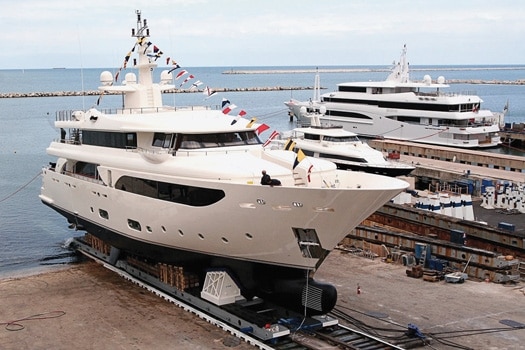
ytgfeb09perf1.jpg
It all started with wine, and when we’re through here, you may be ready for a glass or two yourself. The subject is tons: short tons, long tons, metric tonnes, gross tons, net tons, displacement tons, deadweight tons, register tons, U.S. and international regulatory tons…and tuns. In the beginning, there were only tuns, which are large wooden casks of wine. Each had a capacity of four hogsheads or 252 gallons. Sailing ships were rated by how many tuns of wine they could carry, and were taxed accordingly.
At 252 gallons, a measure of volume, a tun-wine and wood included-is going to weigh a bit upwards of 2,200 pounds, a measure of weight. There’s the first problem. Some tons are volume, some are weight, and boat owners need to know the difference.
Short tons (ST) and long tons (LT) are common maritime measures in the U.S., and metric tons (MT), often spelled tonnes, are used elsewhere. All are measures of weight. A short ton, used ashore and for Great Lakes vessels, is 2,000 pounds. Long tons are the preferred measure for American seagoing ships, and are 2,240 pounds, about the weight of a tun of wine. Metric tonnes, at 2,205 pounds, are also in this range, but it’s coincidental. The weight of a metric tonne is based not on a tun of wine, but on the weight of one cubic meter or one thousand liters of fresh water. Oddly enough, this is 264 gallons, just a little larger than a tun, so the name stuck for the metric system, too.
Displacement tons and deadweight tons (DWT) are measures of weight, too, so they can be short, long, or metric. Displacement is, simply, the weight of the vessel in a given condition, so you’ll often see figures for light displacement, half-load displacement, or full-load displacement tonnage. Displacement tonnage can be determined by physically weighing the vessel (marine lift scales are notoriously inaccurate), or by measuring the draft of the vessel and using curves of form to derive the weight of water that the floating vessel displaces, hence the term displacement. Deadweight tons are the carrying capacity of commercial vessels, i.e. a 50,000 deadweight ton tanker can load up to 50,000 tons of oil before sinking to the loadline painted on its side.
Now comes the fun. Gross tons (GT) and net tons (NT), measures of volume, are used for register and regulatory purposes. Gross tonnage is what is referred to on 100-ton and 1,000-ton captain’s licenses. These are also used for customs, duties, and taxation. In the days of sailing ships and tuns, the agency that would eventually become the U. S. Coast Guard was the Revenue Cutter Service, and it existed not to guard the coast or to monitor oil spills, but to catch smugglers trying to avoid taxes.
When money and government are involved, anything can happen. Knowing today’s income tax code, imagine what over 200 years of laws, bureaucracy, and court rulings have done to the ship tonnage code. Like gross income and taxable income on your IRS form, there is gross tonnage, which is the total interior volume of the ship, calculated at 100 cubic feet per ton, and net tonnage, which takes into account various deductions and exemptions. But just what is total interior volume? Sometimes it’s measured to the hull of the vessel, sometimes to the smaller frames that support the hull plating, and sometimes to the larger stringers that support the smaller frames. Sometimes the deckhouse is included, sometimes not, and amazingly, that decision often depends on the type of bolts used to attach the doors or windows.
As bad as the U.S. tonnage code was, different codes existed in every maritime country-a mess. A few decades ago, the international community developed an international convention that standardized tonnage measurement around the world. That was the theory, but many safety regulations were based on register tonnage as determined under the old national rules, so you’ll find many ships with both a domestic (U.S.) regulatory tonnage rating and an international register tonnage rating. The system didn’t eliminate the complexity of the old one, it added to it. Determination of gross and net tonnage is best left to experts; as a naval architect, I don’t hesitate to hire a tonnage consultant.
Don’t want to keep these tonnages straight in your head? Remember that the tonnage shown on your documentation is not the weight of your yacht and has no correlation to it. Before you have your yacht hauled, know how much it weighs, in short, long, or metric tons, not its measure in gross or net tons. Or you’ll need a tun of wine to face the aftermath.









